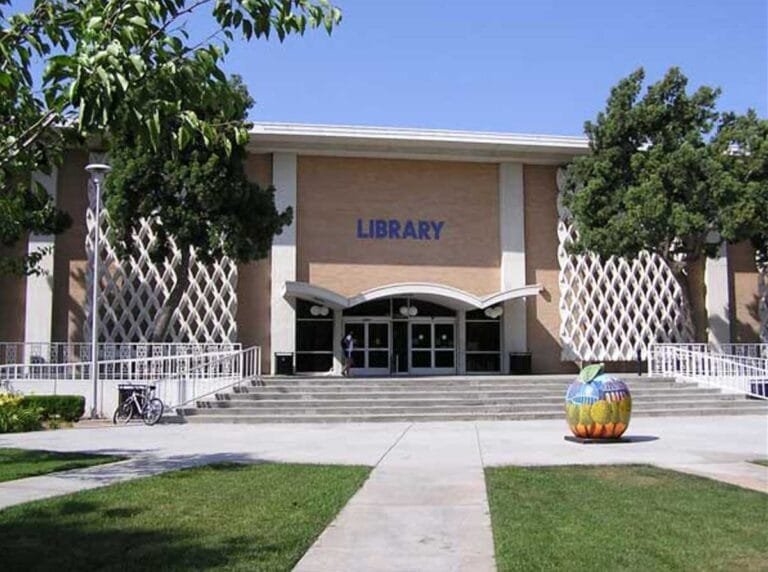Downtown statue honors Riverside citrus pioneer

2011
Downtown pedestrian mall

2011
Pedestal
(Patricia P. Ortlieb is
Eliza’s great-great granddaughter)

2008
Parent Navel
(w/ Eliza’s historical marker)

2009
Original location of trees
(w/ Luther’s historical marker)
After 14 years of planning, a long-awaited statue honoring Riverside citrus pioneer Eliza Tibbets was unveiled last week in downtown.
Spearheaded by Kathryn Gage (a distant relative of Eliza through marriage) and created by artist/sculptor (and former Corona resident) Guy A. Wilson, the 11-foot statue rises above the outdoor pedestrian mall at Sixth Street near the Mission Inn. Entitled “Sower’s Dream,” it commemorates Eliza and her role in originating California’s highly successful navel orange industry.
The 1,100 pound bronze statue depicts Eliza with outstretched arms and billowing dress. It is meant to portray a young Eliza as opposed to the older “Queen Victoria” Eliza most associate with Mrs. Tibbets’ time living in Riverside.
Included on the statue are etchings of navel oranges and a replica of a “Woman’s Relief Corps” medal, no doubt a nod to Eliza’s women’s suffrage activism. Several tiles surrounding the statue include the names of those who helped make it a reality. Planted nearby are two navel orange trees.
The statue honors not only Eliza the navel orange matriarch, but also Eliza the spiritualist, abolitionist and activist. Though quite impressive, our only real complaint is that its homage to Riverside’s navel orange is maybe a bit too subtle and not instantly recognizable by casual passers-by. (Holding an orange in her outstretched hands may have easily done the trick.) Regardless, we give the statue a positive thumbs up.
For those not familiar with local history, Eliza (along with husband Luther) was a pioneer in California’s multi-million dollar navel orange industry. In fact, if not for Eliza, Riverside — and California in general — certainly would have been much different.
In 1873 (or 1875, the exact year is a bit unclear), she secured two small navel orange trees from the U.S. Department of Agriculture for test planting in Riverside (some had been previously — and again later — shipped to Florida, where they failed). Originating as a mutation in Bahia, Brazil, these navel trees took well to Riverside’s semi-arid climate, producing a sweet, succulent and seedless navel orange. (It has been said that Eliza used dishwater to sustain the original trees during dry periods.)
With the first fruits shown to local residents in 1878, and much more widely in 1879 at Riverside’s first formal Citrus Fair, this new citrus variety — sometimes referred to as the “Riverside Navel” but officially known as the “Washington Navel” — quickly became the star attraction. Its taste and texture was found to be far superior than the seeded Valencia variety grown in California’s coastal areas, including nearby Orange County. (In general, Valencia’s are used for juicing while navels are considered much tastier for eating.)
As word of Riverside’s new thick-skinned and sun-kissed orange spread, local growers began requesting — and obtaining — budstock grafted straight from the Tibbets’ two original trees (grafting was required due to the oranges’ lack of seeds). As such, these “parent navel” trees eventually propagated California’s entire navel orange industry, making them one of the most successful fruit introductions in U.S. history.
By 1882, there were more than half a million citrus trees in California, with nearly half planted in the Riverside area alone. Within a short time, a powerful growing/marketing cooperative (California Fruit Growers Exchange, later known as Sunkist) was born and advances in picking and packaging (FMC Corp.) combined with improvements in shipping (refrigerated rail cars) led to a second California “gold rush” of sorts. Soon, wealthy easterners began flocking to Inland Southern California, buying large tracts of land for groves and building impressive homes. As a result, Riverside was the richest city per capita in the U.S. in 1895.
Today, reminders of the city’s citrus legacy are still present, two of which directly credit Eliza and Luther Tibbets. Interestingly, a late fracture in the Tibbets’ family ended up creating two distinct historical markers, both with the same planting year of 1873, but each crediting either Eliza or Luther independently for the trees and their eventual success.
At any rate, the most significant of these two reminders is located at the corner of Magnolia and Arlington avenues where one of the two original parent navel orange trees still stands bearing fruit. Over the years, “grafting” budstock from it remained popular enough that the city eventually needed to protect the remaining parent navel by securing it behind a fence. A plaque placed here in 1920 credits Eliza.
The other significant item directly related to the parent navels is a tiny marker located at the corner of Central Avenue and Navel Court, near where the two trees originally stood at the former Tibbets’ home (long since paved over). This marker, placed in 1935 by Luther’s daughter Minnie Tibbets Mills, credits Luther.
Both parent navel trees were later replanted, one in 1902 at the fenced-off city corner previously mentioned and the other in 1903 (during a visit by President Theodore Roosevelt) to a courtyard inside the Mission Inn, where it died in 1921.
Elsewhere around Riverside are other reminders, including citrus exchange buildings (Arlington Heights / Sunkist | Riverside Navel Growers Assoc.), citrus packinghouses (Sutherland Fruit Co. | E.T. Wall), citrus machinery and shipping facilities, the Gage Canal irrigation system and large swaths of orange groves along Victoria and Dufferin avenues. And of course, there’s the California Citrus State Historic Park, which includes a museum with interpretive exhibits, lush picnic areas, walking paths and working citrus groves.
And although several structures, such as the Mission Inn, Riverside County Courthouse and numerous homes, owe their opulence to the once mighty citrus industry, probably the most significant entity stemming from Riverside’s citrus legacy is the University of California at Riverside (UCR) campus.
What began in 1907 as the Citrus Experiment Station (at the base* of Mount Rubidoux), eventually transformed into a general campus of the University of California system in 1959 (at the base* of Box Springs Mountain — 3 miles to the east).
Today, UCR’s “Citrus Variety Collection” is among the most extensive of its kind in the world. The campus, home to nearly 20,000 students, has greatly expanded beyond its initial focus of citrus research and plays a major role within Inland Southern California’s economy.
And to think, it all began with two, seemingly inconspicuous navel orange trees planted in a fledgling Riverside garden by Eliza Lovell Tibbets.
Photo Gallery: Riverside’s Citrus Legacy
Related
- Guy A. Wilson (sculptor)
- OregonLive.com – Guy Wilson finishes a sculpture of Eliza Tibbets
- History of the Parent Washington Navel Orange Tree (slideshow)
- UC Riverside – Campus History | Citrus Variety Collection | Washington Navel
- California Citrus State Historic Park – State Parks website | Citrus Park website
- Inland Orange Conservancy
- Creating an Orange Utopia: Eliza Lovell Tibbetts and the Birth of California’s Citrus Industry
* Courtesy of UC Riverside
Sources: “A Colony For California” (Tom Patterson), City of Riverside, The Press-Enterprise, Riverside Public Library, “Riverside’s Invisible Past” (Joan H. Hall), Sunkist, WikiPedia.














I like the new statue, but it really doesn’t come across as Eliza to me due to the fact that she was an older woman when she planted the trees. (I like your idea about her holding an orange! That would have been better.) However, it is nice to see a new statue in the middle mall and it is a lovely statue, plus I do like the writing on the front as well that gives a nice summary.
Also, I like how you mentioned how people still dispute if it was Eliza or Luther who planted the trees. Going through the old Riverside Chamber of Commerce boxes at the library I found an old postcard from April 1933 saying Luther planted the trees & it has a drawing of him picking an orange from the tree with a drawing of his house in the bottom left corner. On the back of the postcard it says in part of the writing, “I am asking your kind aid in correcting an error by giving credit to whom it is due. Luther C. Tibbets planted the first navel orange trees – two years before Eliza come to California.”
It is signed by a “M.T. Mills? or Nulls?” of Pismo Beach, CA.
@Krystal — Yes, the statue is quite impressive, even if it’s not exactly the Eliza we’re accustomed to seeing. Those involved with its creation remind us that even older folks were once young (hence, the “younger” Eliza). Btw, we will be adding some more images soon, including one of the older Eliza.
Regarding the dueling planting dates …
Historically, most of the credit for the parent navel trees has been given to Mrs. Tibbets. This is likely due to the fact that according U.S. Department of Agriculture documents, the trees were given to “Mrs. Tibbets, Riverside, Calif.” However, because no one realized at the time the importance of the trees, the actual planting date has never been fully authenticated. Though 1873 has become the “official” date, 1875 is another year often mentioned (and some say, the correct date due to the trees’ fruiting history — we’ve clarified the post a bit in this regards). And, according to the late Tom Patterson in his Riverside history book — A Colony For California — even Luther himself once said the trees were planted in 1874.
To make matters worse, the fracture in the family — namely Luther’s daughter Minnie Tibbets Mills’ attempt to ensure her father received credit over Eliza (as seen with your postcard) — added even more confusion to the trees’ history. Minnie’s claim was that Eliza arrived in Riverside after the 1873 planting. Therefore, she said it was Luther who planted the trees. (Patterson’s book does indicate that Luther indeed arrived in Riverside first, in December 1870, with Eliza joining him sometime in 1873, though some say it was 1874, which could give Luther the “planting” credit.)
Regardless of the actual “planting” date, it’s more than likely that both Eliza and Luther worked together to some extent in obtaining, planting, nourishing, grafting and marketing the parent navel trees (of course, with help later from Sunkist in the all-important marketing department). And the result was the most sought-after, best tasting and highly successful navel orange in the world.